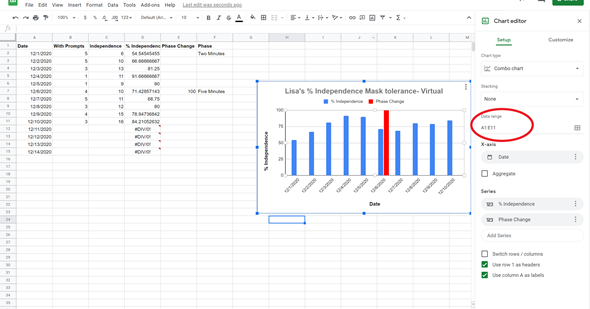10 Mask Wearing Tips (Virtual and Classroom)
Note- this was developed for a classroom that primarily provided Special Ed Services
Virtual Instruction
Practice wearing a mask during the virtual setting.
Treat mask-wearing like any other skill (materials should be easy to access and break the tasks down into steps). See the example below. Do not assume students know how to wear/put on masks. Think of it as starting over with a clean slate. You are creating/teaching the expectation for your classroom (yes, even in the virtual setting). You may have to differentiate as some students may have printed masks. You may also choose to show a video on how to wear a mask. An example of steps is below. Remember to review non-examples as well.
Step 1: Get mask (before step one, you should ensure they have a clean mask available- this will require parent communication. Maybe the student keeps the mask in a specific place in their work area)
Step 2: Put the strap on the right ear
Step 3: Put the strap on the left ear
Step 4: Pull mask over your nose
Step 5: Check yourself in the mirror/camera
Create a reinforcement system for appropriate mask use (create a different reinforcement system or add to your current system).
This can be individual or group. Modify based on student performance
Remember to complete reinforcer assessment(s)
Take individual data on this process (example data/graph). Access the google sheet. Modify and make copies as needed. Phase Change lines are included (it is important to show different phases {in this situation time} throughout the data collection process).
Below is a photo with additional information on modifying the graph **
There are multiple datasheet examples. You do not have to use these examples, but you should collect data on the skill. This is valuable information for all parties.
Build behavior momentum in wearing a mask.
This can look like starting with a small period of time and increasing time as students successfully meet the goal (this is key- you should NOT increase period if the learner is not successful- in this case, you may have to revisit reinforcer and/or reteach)
Use videos and other written materials to review the topic with students
Teach students how to greet each other when they return to school
Include parents in the planning, implementation, and reinforcement. Remember that this is now a life skill. Student success in wearing masks can have a positive impact on the entire family!
Show students the classroom/building before they return (similar to a virtual tour). In addition to the classroom, this would include the closest bathroom, lining up for the bus, going to the bus, etc.
Classroom (In-Person)
While setting up your classroom, as space allows, create an individual work area (not a student-specific desk) ideally in the corners of your classroom (away from other students). Think of this as a “mask break” area. We are not saying that it is ok for students to walk around your classroom without a mask. We are recommending to plan for the inevitable and teach students an appropriate area (if any) to take their masks off for a minute (after all, remember they are taking their masks off to eat and drink). This area is more than 6 feet away from others. Again- use this as a teaching opportunity and reinforce student access to the area (do not highlight aka high praise- you want to make sure that aren’t encouraging students to take their mask off and go to that area. Your goal is to plan for the inevitable (student taking a mask off), reinforce teaching (maintain distance), and wearing the mask appropriately. Ask building admin (ex. Principal, AP) about PPE (ex. plexiglass) as needed.
Work with your colleagues and create a cleaning schedule for the classroom.
This can look like: after session one person A wipes down ______
Review expectations with students. Ideally, the system you had in place virtually should transfer to face to face.
Remember: their buy-in and participation are keys to success.
Use this as an opportunity to incorporate social skills. Students can practice reminding the other student of appropriate mask use
Take individual data on each student. Based on the student, you may modify the datasheet. With modification, you want to make sure it captures the student’s performance.
Most important: REINFORCE REINFORCE REINFORCE
Action item: Check in with your child’s school team to see how you can support this skill.
Join our email list to receive a free guide on actionable steps to complete before, during, and after your annual IEP.


